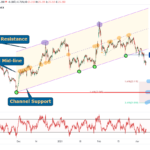Yesterday’s trade (in GMT terms) saw GBP/USD within the range of 1.2686-1.2773. The pair closed at 1.2750, rebounding 0.17% compared to Tuesdays close. It has been the 164th gain in the past 353 trading days. The daily low has been a level unseen since June 1985. The major pair has trimmed its slump to 1.76% so far during the current month, after losing 1.23% in September.
At 6:56 GMT today GBP/USD was edging down 0.28% on the day to trade at 1.2714. The pair touched a daily high at 1.2762 during the early phase of the Asian trading session, undershooting the daily R2 level, and a daily low at 1.2696 during early European trade.
On Thursday GBP/USD trading may be influenced by the following macroeconomic report listed below.
Fundamentals
United States
Initial, Continuing Jobless Claims
The number of people in the United States, who filed for unemployment assistance for the first time during the business week ended on September 30th, probably rose to 256 000, according to market consensus, from 254 000 in the preceding week.
The 4-week moving average, an indicator lacking seasonal effects, was 256 000, marking a decrease by 2 250 compared to the preceding week’s unrevised average. It matched a level in April this year and has also been the lowest average since 1973.
The business week, which ended on September 23rd, has been the 82nd consecutive week, when jobless claims stood below the 300 000 threshold, which suggested a healthy labor market. It has been the longest streak since 1970.
Initial jobless claims number is a short-term indicator, reflecting lay-offs in the country. In case the number of claims met expectations or increased further, this would have a moderate bearish effect on the US dollar.
The number of continuing jobless claims probably rose to the seasonally adjusted 2 074 000 during the business week ended on September 23rd, according to the median forecast by experts, from 2 062 000 in the preceding week. The latter represented a decrease by 46 000 compared to the revised down number of claims reported in the week ended on September 9th. It has also been the lowest level for insured unemployment since July 1st 2000, when 2 052 000 claims were reported. This indicator reflects the actual number of people unemployed and currently receiving unemployment benefits, who filed for unemployment assistance at least two weeks ago.
The US Department of Labor is to release the weekly report at 12:30 GMT.
Bond Yield Spread
The yield on UK 2-year government bonds went up as high as 0.142% on October 5th, or the highest level since September 20th (0.144%), after which it closed at 0.114% to lose 1.2 basis points (0.012 percentage point) compared to October 4th.
Meanwhile, the yield on US 2-year government bonds climbed as high as 0.857% on October 5th, or the highest level since August 29th (0.857%), after which it fell to 0.838% at the close to add 1.2 basis points (0.012 percentage point) compared to October 4th.
The spread between 2-year US and 2-year UK bond yields, which reflects the flow of funds in a short term, widened to 0.724% on October 5th from 0.700% on October 4th. The October 5th yield spread has been the largest one so far this year.
Daily, Weekly and Monthly Pivot Levels
By employing the Camarilla calculation method, the daily levels of importance for GBP/USD are presented as follows:
R1 – 1.2758
R2 – 1.2766
R3 (Range Resistance – Sell) – 1.2774
R4 (Long Breakout) – 1.2798
R5 (Breakout Target 1) – 1.2826
R6 (Breakout Target 2) – 1.2837
S1 – 1.2742
S2 – 1.2734
S3 (Range Support – Buy) – 1.2726
S4 (Short Breakout) – 1.2702
S5 (Breakout Target 1) – 1.2674
S6 (Breakout Target 2) – 1.2663
By using the traditional method of calculation, the weekly levels of importance for GBP/USD are presented as follows:
Central Pivot Point – 1.2984
R1 – 1.3053
R2 – 1.3127
R3 – 1.3196
R4 – 1.3264
S1 – 1.2910
S2 – 1.2841
S3 – 1.2767
S4 – 1.2692
In monthly terms, for GBP/USD we have the following pivots:
Central Pivot Point – 1.3113
R1 – 1.3312
R2 – 1.3645
R3 – 1.3844
R4 – 1.4042
S1 – 1.2780
S2 – 1.2581
S3 – 1.2248
S4 – 1.1914





